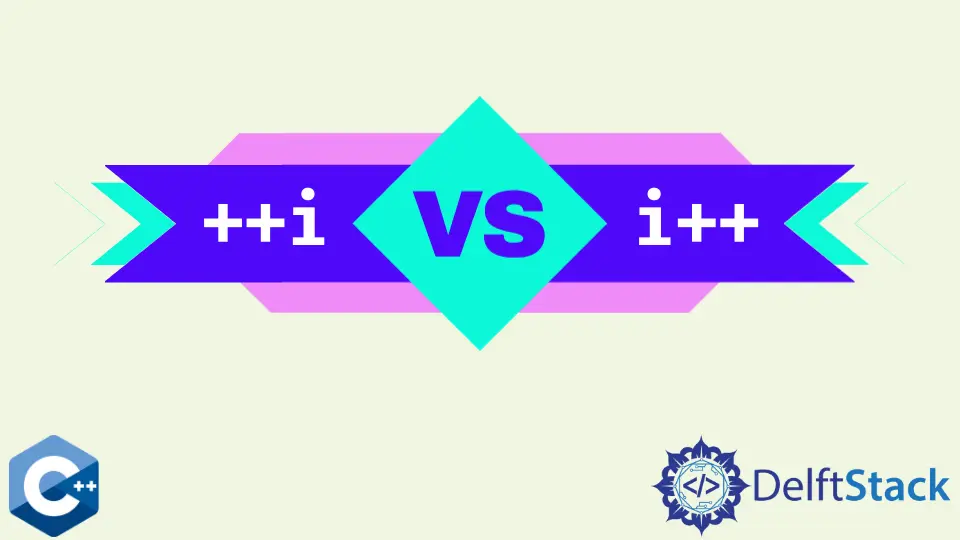C++ 中的前遞增 VS 後遞增運算子

本文將介紹 C++ 中前自增和後自增的區別。
C++ 中預增和後增運算的區別
這兩種操作都基於一元增量運算子 - ++,當在訪問變數值的表示式中使用時,它的行為略有不同。通常,變數可以在之後或之前與遞增或遞減運算子組合,從而產生更大/更小 1 的值。但請注意,預遞增操作首先修改給定的變數,然後訪問它。另一方面,後遞增運算子訪問原始值,然後遞增它。因此,當在訪問或儲存值的表示式中使用時,運算子可以對程式產生不同的影響。例如,以下示例程式碼將兩個整數初始化為 0 值,然後迭代五次,同時使用不同的運算子輸出每個整數的遞增值。請注意,後增量以 0 開始列印並以 4 結束,而預增量以 1 開始並以 5 結束。儘管如此,儲存在兩個整數中的最終值是相同的 - 5。
#include <iostream>
using std::cout;
using std::endl;
int main() {
int i = 0, j = 0;
while ((i < 5) && (j < 5)) {
cout << "i: " << i++ << " ";
cout << "j: " << ++j << endl;
}
cout << "End of the loop, both have equal values:" << endl;
cout << "i: " << i << " "
<< "j: " << j << endl;
exit(EXIT_SUCCESS);
}
輸出:
i: 0 j: 1
i: 1 j: 2
i: 2 j: 3
i: 3 j: 4
i: 4 j: 5
End of the loop, both have equal values:
i: 5 j: 5
或者,在 for 迴圈的條件表示式中使用不同的符號表現相同。兩個迴圈都執行 5 次迭代。儘管如此,使用預增量通常是公認的風格,當程式碼未優化時,這可能是一種更高效的變體。
#include <iostream>
using std::cout;
using std::endl;
int main() {
int i = 0, j = 0;
while ((i < 5) && (j < 5)) {
cout << "i: " << i++ << " ";
cout << "j: " << ++j << endl;
}
cout << "End of the loop, both have equal values:" << endl;
cout << "i: " << i << " "
<< "j: " << j << endl;
cout << endl;
for (int k = 0; k < 5; ++k) {
cout << k << " ";
}
cout << endl;
for (int k = 0; k < 5; k++) {
cout << k << " ";
}
cout << endl;
exit(EXIT_SUCCESS);
}
輸出:
i: 0 j: 1
i: 1 j: 2
i: 2 j: 3
i: 3 j: 4
i: 4 j: 5
End of the loop, both have equal values:
i: 5 j: 5
0 1 2 3 4
0 1 2 3 4
不要將後遞增和前遞增操作與相同變數的其他算術運算一起使用
請注意,當與同一變數一起使用時,後增量和前增量運算子可能會使算術計算完全錯誤。例如,將後增量與相同變數的乘法相結合會使程式碼不直觀,如果處理不當甚至容易出錯。
#include <iostream>
#include <vector>
using std::cout;
using std::endl;
using std::vector;
int main() {
vector<int> vec1 = {10, 22, 13, 41, 51, 15};
for (int &k : vec1) {
cout << k++ * k << ", ";
}
exit(EXIT_SUCCESS);
}
輸出:
110, 506, 182, 1722, 2652, 240,
Founder of DelftStack.com. Jinku has worked in the robotics and automotive industries for over 8 years. He sharpened his coding skills when he needed to do the automatic testing, data collection from remote servers and report creation from the endurance test. He is from an electrical/electronics engineering background but has expanded his interest to embedded electronics, embedded programming and front-/back-end programming.
LinkedIn